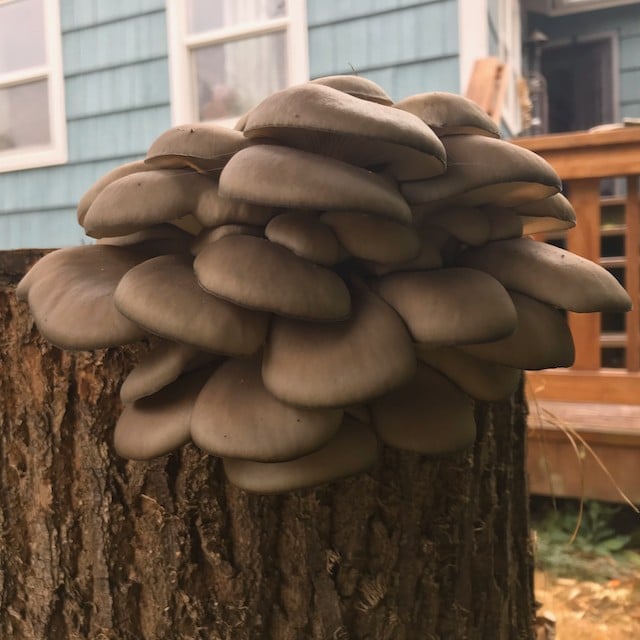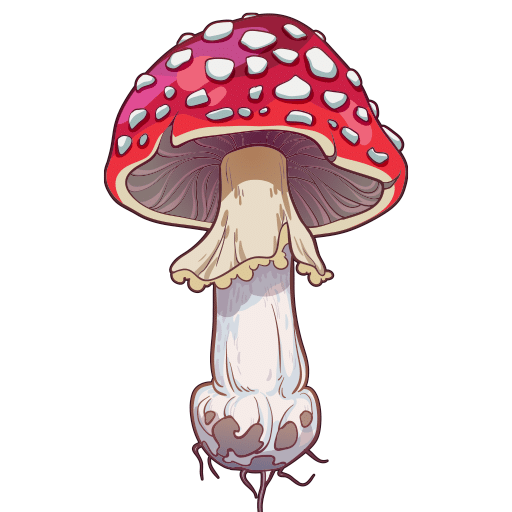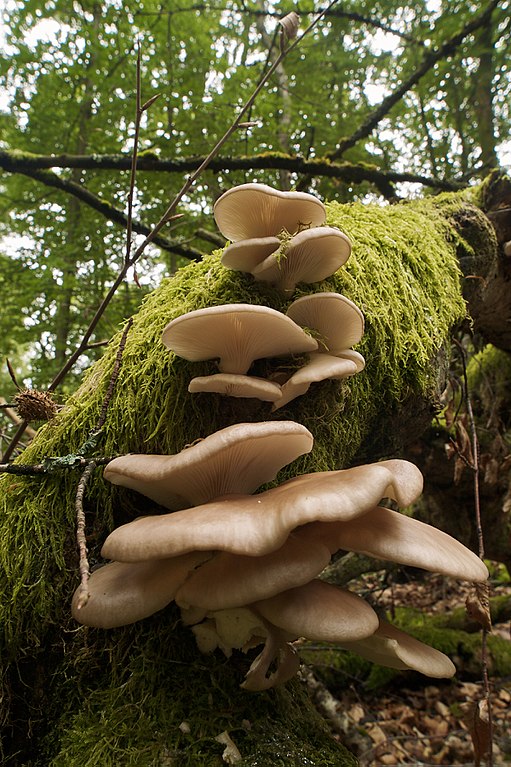Pleorotis djamor
Common Name(s)
Pink Oyster
Preferred Substrates
Hardwood sawdust, Straw (wheat or rice), Supplemented with wheat or rice bran, Corn cobs, Cottonseed hulls, Coffee grounds
Environmental Conditions
Spawn Run: 75-85
Pinning Initiation: 70-75
Fruitbody Development: 65-70
Difficulty
Easy
Notes
Pleurotus djamor is a tropical oyster mushroom with a striking pink color and a delicate, velvety texture. Popular in gourmet cuisine for its visual appeal and mild, slightly sweet taste. The pink color tends to fade when cooked or exposed to heat.
Pleurotus ostreatus var. columbinus

Common Name(s)
Blue Oyster, Pleurotus columbinus
Preferred Substrates
Hardwood sawdust, Straw (wheat or rice), Supplemented with wheat or rice bran, Coffee grounds, Hardwood logs (oak, beech, or alder)
Environmental Conditions
Spawn Run: 70-75
Pinning Initiation: 65-70
Fruitbody Development: 55-60
Difficulty
Easy
Notes
Pleurotus ostreatus var. columbinus is a variety of oyster mushroom known for its attractive blue-gray color and fan-shaped caps. Appreciated for its mild, slightly sweet taste and tender texture.
Pleurotus pulmonarius
Common Name(s)
Phoenix/Indian/Lung/Summer Oyster mushroom
Preferred Substrates
Hardwood sawdust, Straw (wheat or rice), Supplemented with wheat or rice bran, Coffee grounds, Hardwood logs (oak, beech, or alder)
Environmental Conditions
Spawn Run: 70-75
Pinning Initiation: 65-70
Fruitbody Development: 60-65
Difficulty
Easy
Notes
Pleurotus pulmonarius is an oyster mushroom variety that is similar in appearance to Pleurotus ostreatus but with a thinner, more delicate flesh and a preference for warmer temperatures. The mushrooms have a mild, slightly sweet taste and a tender texture.
Pleurotus citrinopileatus
Common Name(s)
Golden Oyster mushroom, Yellow Oyster mushroom
Preferred Substrates
Hardwood sawdust, Straw (wheat or rice), Supplemented with wheat or rice bran, Coffee grounds, Hardwood logs (oak, beech, or alder)
Environmental Conditions
Spawn Run: 70-75
Pinning Initiation: 65-70
Fruitbody Development: 60-65
Difficulty
Easy
Notes
Its origins are not well known but this seems to be a mushroom that has gained a foothold in the eastern US after escaping from a cultivation environment.
Pleurotus cornucopiae
Common Name(s)
Branched Oyster, Horn of Plenty Oyster
Preferred Substrates
Hardwood sawdust, Straw (wheat or rice), Supplemented with wheat or rice bran, Coffee grounds, Hardwood logs (oak, beech, or alder)
Environmental Conditions
Spawn Run: 70-75
Pinning Initiation: 65-70
Fruitbody Development: 60-65
Difficulty
Easy
Notes
Pleurotus cornucopiae, also known as the horn of plenty mushroom, is a type of oyster mushroom that is popular in Mediterranean cuisine. It has a delicate flavor and a firm, meaty texture. Like other oyster mushrooms, it is high in protein, fiber, and essential minerals like potassium and phosphorus. It also contains antioxidants and beta-glucans, which may have immune-boosting and anti-cancer effects. It is also being studied for its potential use in bioremediation, as it has been shown to be effective in breaking down harmful chemicals in contaminated soils.
Pleurotus eryngii
Common Name(s)
King Oyster, King Trumpet, French Horn mushroom
Preferred Substrates
Hardwood sawdust, Straw (wheat or rice), Supplemented with wheat or rice bran, Coffee grounds, Hardwood logs (oak, beech, or alder)
Environmental Conditions
Spawn Run: 70-75
Pinning Initiation: 65-70
Fruitbody Development: 60-65
Difficulty
Easy
Notes
Pleurotus eryngii is the largest of the oyster mushroom family, with a thick, meaty stem and a small, tender cap. Its dense, robust texture and umami-rich flavor make it a popular choice for vegetarian and vegan dishes as a meat substitute. Unlike other oyster mushrooms, King Oyster mushrooms have a longer shelf life, making them more suitable for commercial production and transportation. King Oyster mushrooms have been found to contain compounds that support immune system function and may possess anti-cancer properties. Pleurotus eryngii can grow in a wide range of temperatures, making it suitable for cultivation in various climates. The natural environment of King Oyster mushrooms is the Mediterranean region, where they grow on the roots of plants in the carrot family (Apiaceae).
Pleurotus ostreatus
Common Name(s)
Pearl Oyster, Tree Oyster mushroom
Preferred Substrates
Hardwood sawdust, Straw (wheat or rice), Supplemented with wheat or rice bran, Coffee grounds, Hardwood logs (oak, beech, or alder)
Environmental Conditions
Spawn Run: 70-75
Pinning Initiation: 65-70
Fruitbody Development: 55-60
Difficulty
Easy
Notes
Pleurotus ostreatus is one of the most widely cultivated and consumed oyster mushrooms worldwide, known for its delicate flavor and tender texture. The mushrooms have a fan or oyster-shaped cap, which is where their name originates. Oyster mushrooms are natural decomposers, breaking down dead organic matter, and have been studied for their potential in bioremediation (breaking down pollutants in contaminated environments). Pleurotus ostreatus has been found to contain compounds with antimicrobial, anti-inflammatory, and antioxidant properties, as well as potential anti-cancer and cholesterol-lowering effects. Oyster mushrooms can grow on a variety of organic waste materials, making them an environmentally sustainable option for mushroom cultivation. Pleurotus ostreatus is highly adaptable, growing in various climates and conditions, making it a popular choice for both commercial and home cultivation.






